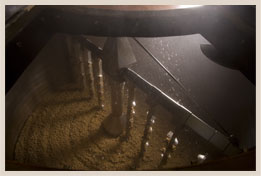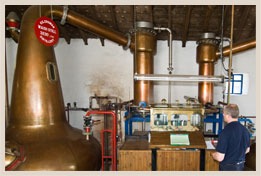
The olfactory and gustatory palette of Scottish single malts is the fruit of complex chemistry. The water, barley, yeasts, peat, size and shape of the stills, cask maturation, climate, time factor, and the expertise of the distiller all help forge their unique character. But which of all of these elements influences the aromas, texture and flavours of a single malt the most? In order to answer this, an analysis of the main stages of production is required.
Do the whisky’s aromas come from the raw ingredients?

Single malts are the result of a combination of water, malted barley and yeast. Water is involved in various stages of production. First and foremost, water is the main ingredient that is incorporated during brewing. It is also vital in the stage before bottling, when the whisky is reduced with water. While it is usually filtered, it still retains various characteristics. In Scotland, it flows through granite, which makes it very soft. Some distilleries use harder (limestone) water that concentrates the aromas during fermentation. Though the source of the water is closely linked to each distillery’s region of production, the same cannot be said for barley, the other main ingredient in the production of a single malt. On top of its geographical origins and its aromatic potential, it is its intrinsic properties that determine its quality. The best barley should be rich in starch, as these are the sugars that are converted into alcohol through the action of the yeast.
What role do yeasts really play?

Yeasts are single-celled micro-organisms from the mushroom family capable of causing fermentation. Distilleries can use two types of yeast: brewer’s yeast and distiller’s yeast, also known as culture yeast. The use of brewer’s yeast is becoming increasingly less common today. Yeasts notably bring fruity and floral notes (strawberry, lavender), an issue that is subject to much taboo. Distilleries in fact tend to minimise their impact, out of fear of arousing controversy and impacting the “pure” image attributed to whisky.
What influence do stills have on a whisky?

After fermentation, the wash (fermented must at about 6 to 8% ABV) is distilled in copper pot stills whose size and shape influence the character of the whisky (body, lightness, breadth and aromatic complexity). A tall still will produce a light whisky. Despite this process becoming increasingly computerised, the role of the stillman - the master distiller - remains crucial. It is their role to collect the new spirit, the heart of the run, and to run off the feints and foreshots produced during distillation. The foreshots, or heads, are rich in aromatic esters and acids. The feints, or tails, are rich in sulphur and heavy aromatic elements. The taste and character of the whisky depends largely on the interval during which the stillman collects the heart of the run. Therefore, when a whisky is marked by vegetable and rotten egg notes, this is the result of a higher level of feints being present in the new-make spirit.
Which elements play a role in the maturation of a whisky?

The neutral spirit obtained after distillation acquires its colour during maturation. The origin, nature and size of the casks are amongst the factors that add to the aromatic palette of a whisky. In the case of Speyside malts, the cask is allegedly responsible for 80% of the whisky’s aromas. The peat is the only element whose aromatic potential rivals that of the cask. Peat, which is sometimes used during malting, serves as a fuel when drying the malt. Nevertheless, the peat needs the cask in order for its potential to be revealed. The combination of these two elements leads to single malts with a rare complexity. Two other factors, time and the climate, shape the whisky, bringing it increased suppleness and the iodine nuances transmitted by the ocean spray. The filtration and dilution that precede bottling also influence the texture and aromas of the whisky. In this way, a whisky that is less filtered and diluted will be more expressive.
It should be noted that the image that is frequently presented of a single malt drawing its aromas from a pure, crystalline source of water and locally grown malted barley, now seems to be completely outdated. Despite all of this, the distilleries themselves are nonetheless incapable of explaining every aspect of the whisky’s character. There is an unknown aspect that has an influence on the whisky that escapes all analysis. That’s why alchemy really is the right word.